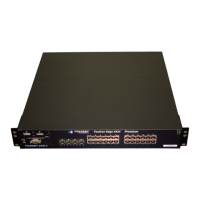Foundry Configuration Guide for the FESX, FSX, and FWSX
13 - 8 © Foundry Networks, Inc. December 22, 2005
Marking
Marking is the process of changing the packet’s QoS information (the 802.1p and DSCP information in a packet)
for the next hop. For example, for traffic coming from a device that does not support DiffServ, you can change the
packet’s IP Precedence value into a DSCP value before forwarding the packet.
You can mark a packet’s Layer 2 CoS value, its Layer 3 DSCP value, or both values. The Layer 2 CoS or DSCP
value the device marks in the packet is the same value that results from mapping the packet’s QoS value into a
Layer 2 CoS or DSCP value.
Marking is optional and is disabled by default. Marking is performed using ACLs. When marking is not used, the
device still performs the mappings listed in “Classification” for scheduling the packet, but leaves the packet’s QoS
values unchanged when the device forwards the packet.
For configuration syntax, rules, and examples of QoS marking, see “QoS Options for IP ACLs” on page 12-23.
Configuring DSCP-Based QoS
FastIron IronWare releases support basic DSCP-based QoS (also called Type of Service (ToS) based QoS) as
described in this chapter. However, the FastIron family of switches do not support other advanced DSCP-based
QoS features as described in the Foundry Enterprise Configuration and Management Guide.
Foundry FastIron IronWare releases also support marking of the DSCP value. FastIron devices can read Layer 3
Quality of Service (QoS) information in an IP packet and select a forwarding queue for the packet based on the
information. The software interprets the value in the six most significant bits of the IP packet header’s 8-bit ToS
field as a Diffserv Control Point (DSCP) value, and maps that value to an internal forwarding priority.
The internal forwarding priorities are mapped to one of the eight forwarding queues (qosp0 – qosp7) on FESX,
FSX, and FWSX devices. During a forwarding cycle, the device gives more preference to the higher numbered
queues, so that more packets are forwarded from these queues. So for example, queue qosp7 receives the
highest preference while queue qosp0, the best-effort queue, receives the lowest preference.
Application Notes
• DSCP-based QoS is not automatically honored for routed and switched traffic. The default is 802.1p to CoS
mapping. To honor DSCP-based QoS, you must change the priority mapping to DSCP to CoS mapping. See
“Using ACLs to Honor DSCP-based QoS” .
When DSCP marking is enabled on the FESX, FWSX, or FSX, the device changes the contents of the inbound
packet’s ToS field to match the DSCP-based QoS value. This is different than on the BigIron, which marks the
outbound packet’s ToS field.
Using ACLs to Honor DSCP-based QoS
FESX, FSX, and FWSX devices require the use of an ACL to honor DSCP-based QoS for routed traffic in the
Layer 3 image, or for switched traffic in the Layer 2 image. To enable DSCP-based QoS on these devices, apply
an ACL entry such as the following:
FESX424 Router(config)# access-list 101 permit ip any any dscp-cos-map
Configuring the QoS Mappings
You can optionally change the following QoS mappings:
• DSCP –> internal forwarding priority
• Internal forwarding priority –> hardware forwarding queue
The mappings are globally configurable and apply to all interfaces.

